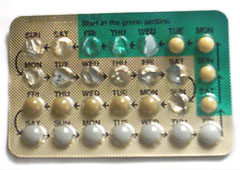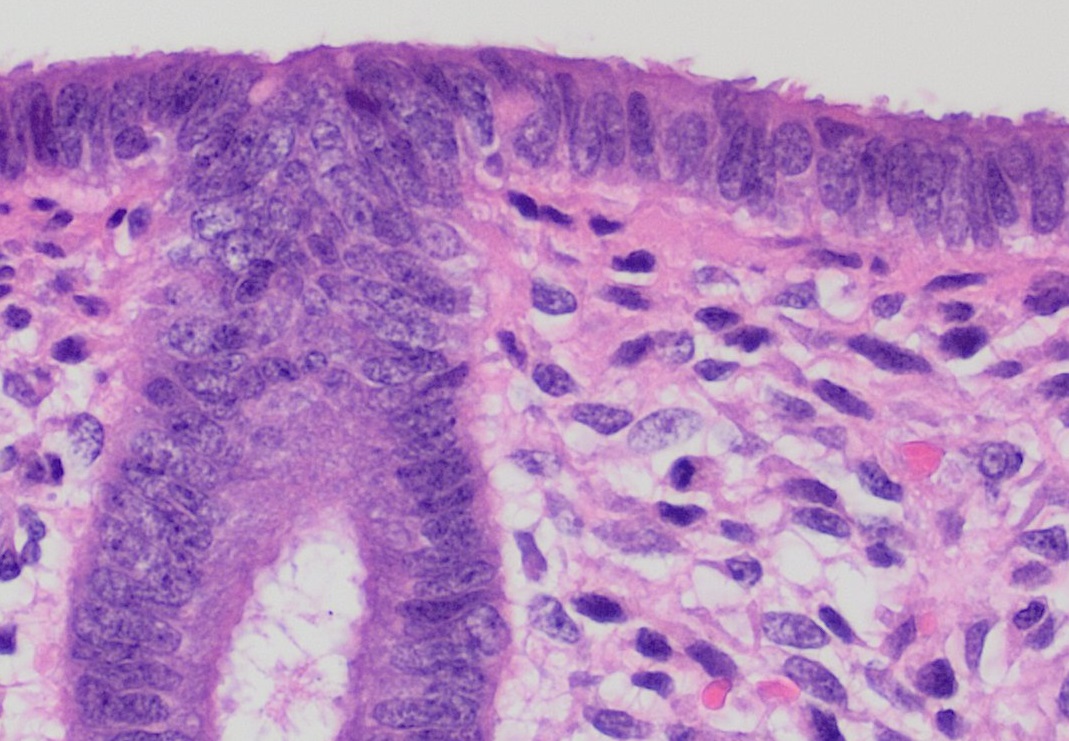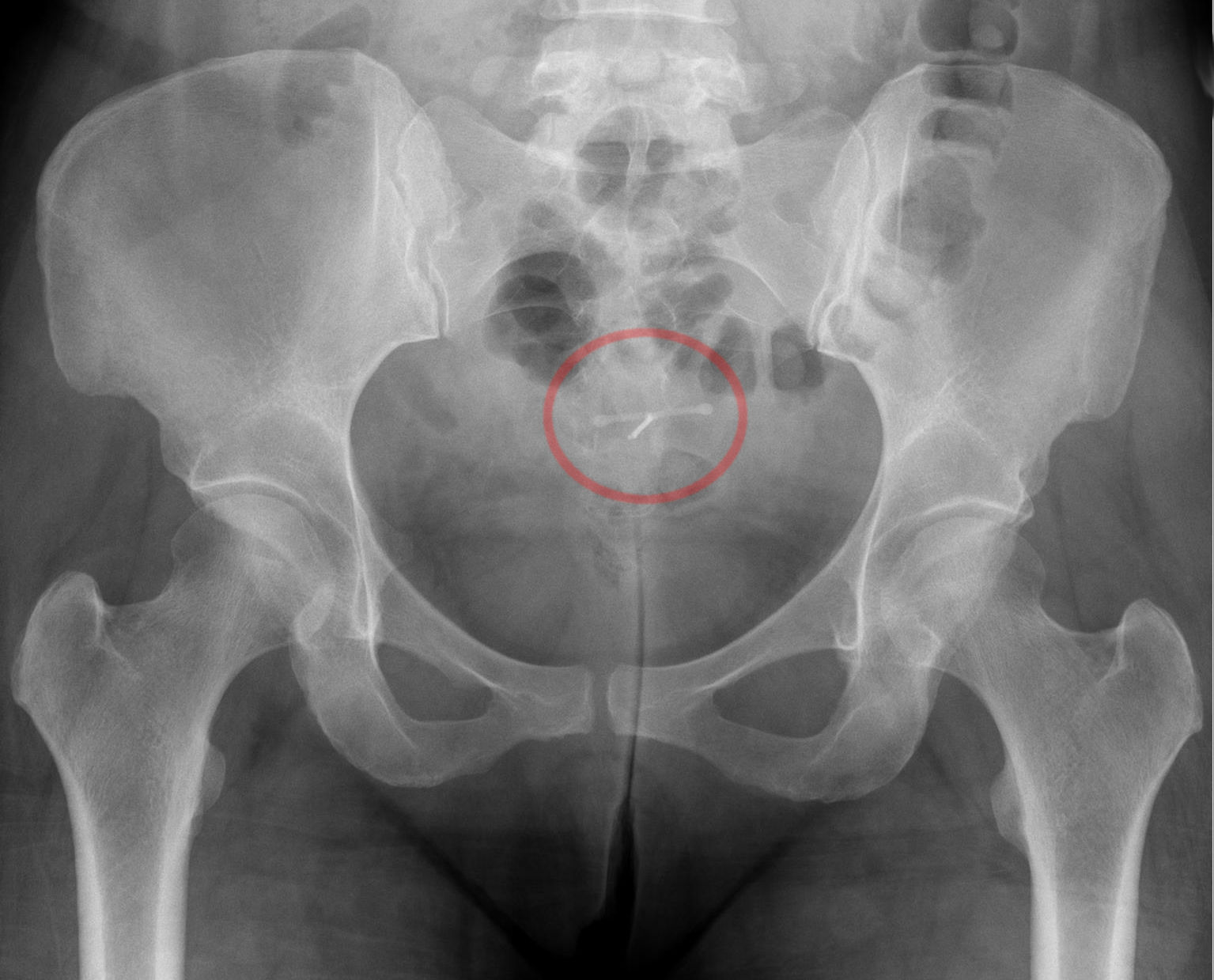|
Endometriosis
Endometriosis is a disease of the female reproductive system in which cells similar to those in the endometrium, the layer of tissue that normally covers the inside of the uterus, grow outside the uterus. Most often this is on the ovaries, fallopian tubes, and tissue around the uterus and ovaries; in rare cases it may also occur in other parts of the body. Some symptoms include pelvic pain, heavy periods, pain with bowel movements, and infertility. Nearly half of those affected have chronic pelvic pain, while in 70% pain occurs during menstruation. Pain during sexual intercourse is also common. Infertility occurs in up to half of affected individuals. About 25% of individuals have no symptoms and 85% of those seen with infertility in a tertiary center have no pain. Endometriosis can have both social and psychological effects. The cause is not entirely clear. Risk factors include having a family history of the condition. The areas of endometriosis bleed each month (menstrua ... [...More Info...] [...Related Items...] OR: [Wikipedia] [Google] [Baidu] |
Endometriosis And Infertility
Endometriosis and its complications are a major cause of female infertility. Endometriosis is a dysfunction characterized by the migration of endometrial tissue to areas outside of the endometrium of the uterus. The most common places to find stray tissue are on ovaries and fallopian tubes, followed by other organs in the lower abdominal cavity such as the bladder and intestines. Typically, the endometrial tissue adheres to the exteriors of the organs, and then creates attachments of scar tissue called adhesions that can join adjacent organs together. The endometrial tissue and the adhesions can block a fallopian tube and prevent the meeting of ovum and sperm cells, or otherwise interfere with fertilization, implantation and, rarely, the carrying of the fetus to term. Endometriosis is estimated to occur in 1% to 5% of women, with an associated risk of infertility for between 30% and 50% of this population. Endometriosis is commonly classified under the revised American Society for R ... [...More Info...] [...Related Items...] OR: [Wikipedia] [Google] [Baidu] |
Gonadotropin-releasing Hormone Agonist
A gonadotropin-releasing hormone agonist (GnRH agonist) is a type of medication which affects gonadotropins and sex hormones. They are used for a variety of indications including in fertility medicine and to lower sex hormone levels in the treatment of hormone-sensitive cancers such as prostate cancer and breast cancer, certain gynecological disorders like heavy periods and endometriosis, high testosterone levels in women, early puberty in children, as a part of transgender hormone therapy, and to delay puberty in transgender youth among other uses. GnRH agonists are given by injections into fat, as implants placed into fat, and as nasal sprays. Side effects of GnRH agonists are related to sex hormone deficiency and include symptoms of low testosterone levels and low estrogen levels such as hot flashes, sexual dysfunction, vaginal atrophy, penile atrophy, osteoporosis, infertility, and diminished sex-specific physical characteristics. They are agonists of the GnRH ... [...More Info...] [...Related Items...] OR: [Wikipedia] [Google] [Baidu] |
Combined Oral Contraceptive Pill
The combined oral contraceptive pill (COCP), often referred to as the birth control pill or colloquially as "the pill", is a type of birth control that is designed to be taken orally by women. The pill contains two important hormones: progestin (a synthetic form of the hormone progestogen/progesterone) and estrogen (usually ethinylestradiol and 17β estradiol). When taken correctly, it alters the menstrual cycle to eliminate ovulation and prevent pregnancy. COCPs were first approved for contraceptive use in the United States in 1960, and are a very popular form of birth control. They are used by more than 100 million women worldwide and by about 9 million women in the United States. From 2015 to 2017, 12.6% of women aged 15–49 in the US reported using COCPs, making it the second most common method of contraception in this age range (female sterilization is the most common method). Use of COCPs, however, varies widely by country, age, education, and marital status. For exam ... [...More Info...] [...Related Items...] OR: [Wikipedia] [Google] [Baidu] |
Pelvic Pain
Pelvic pain is pain in the area of the pelvis. Acute pain is more common than chronic pain. If the pain lasts for more than six months, it is deemed to be chronic pelvic pain. It can affect both the male and female pelvis. Common causes in include: endometriosis in women, bowel adhesions, irritable bowel syndrome, and interstitial cystitis. The cause may also be a number of poorly understood conditions that may represent abnormal psychoneuromuscular function. The role of the nervous system in the genesis and moderation of pain is explored. The importance of psychological factors is discussed, both as a primary cause of pain and as a factor which affects the pain experience. As with other chronic syndromes, the biopsychosocial model offers a way of integrating physical causes of pain with psychological and social factors. Terminology Pelvic pain is a general term that may have many causes, listed below. The subcategorical term urologic chronic pelvic pain syndrome (UCPPS) is an ... [...More Info...] [...Related Items...] OR: [Wikipedia] [Google] [Baidu] |
Chronic Pelvic Pain
Pelvic pain is pain in the area of the pelvis. Acute pain is more common than chronic pain. If the pain lasts for more than six months, it is deemed to be chronic pelvic pain. It can affect both the male and female pelvis. Common causes in include: endometriosis in women, bowel adhesions, irritable bowel syndrome, and interstitial cystitis. The cause may also be a number of poorly understood conditions that may represent abnormal psychoneuromuscular function. The role of the nervous system in the genesis and moderation of pain is explored. The importance of psychological factors is discussed, both as a primary cause of pain and as a factor which affects the pain experience. As with other chronic syndromes, the biopsychosocial model offers a way of integrating physical causes of pain with psychological and social factors. Terminology Pelvic pain is a general term that may have many causes, listed below. The subcategorical term urologic chronic pelvic pain syndrome (UCPPS) is an ... [...More Info...] [...Related Items...] OR: [Wikipedia] [Google] [Baidu] |
Dyspareunia
Dyspareunia ( ) is painful sexual intercourse due to medical or psychological causes. The term ''dyspareunia'' covers both female dyspareunia and male dyspareunia, but many discussions that use the term without further specification concern the female type, which is more common than the male type. In females, the pain can primarily be on the external surface of the genitalia, or deeper in the pelvis upon deep pressure against the cervix. Medically, dyspareunia is a pelvic floor dysfunction and is frequently underdiagnosed. It can affect a small portion of the vulva or vagina or be felt all over the surface. Understanding the duration, location, and nature of the pain is important in identifying the causes of the pain. Numerous physical, psychological, and social or relationship causes can contribute to pain during sexual encounters. Commonly, multiple underlying causes contribute to the pain. The pain can be acquired or congenital. Symptoms of dyspareunia may also occur after men ... [...More Info...] [...Related Items...] OR: [Wikipedia] [Google] [Baidu] |
Endometrium
The endometrium is the inner epithelial layer, along with its mucous membrane, of the mammalian uterus. It has a basal layer and a functional layer: the basal layer contains stem cells which regenerate the functional layer. The functional layer thickens and then is shed during menstruation in humans and some other mammals, including apes, Old World monkeys, some species of bat, the elephant shrew and the Cairo spiny mouse. In most other mammals, the endometrium is reabsorbed in the estrous cycle. During pregnancy, the glands and blood vessels in the endometrium further increase in size and number. Vascular spaces fuse and become interconnected, forming the placenta, which supplies oxygen and nutrition to the embryo and fetus.Blue Histology - Female Reproductive System . School ... [...More Info...] [...Related Items...] OR: [Wikipedia] [Google] [Baidu] |
Pelvic Pain
Pelvic pain is pain in the area of the pelvis. Acute pain is more common than chronic pain. If the pain lasts for more than six months, it is deemed to be chronic pelvic pain. It can affect both the male and female pelvis. Common causes in include: endometriosis in women, bowel adhesions, irritable bowel syndrome, and interstitial cystitis. The cause may also be a number of poorly understood conditions that may represent abnormal psychoneuromuscular function. The role of the nervous system in the genesis and moderation of pain is explored. The importance of psychological factors is discussed, both as a primary cause of pain and as a factor which affects the pain experience. As with other chronic syndromes, the biopsychosocial model offers a way of integrating physical causes of pain with psychological and social factors. Terminology Pelvic pain is a general term that may have many causes, listed below. The subcategorical term urologic chronic pelvic pain syndrome (UCPPS) is an ... [...More Info...] [...Related Items...] OR: [Wikipedia] [Google] [Baidu] |
Irritable Bowel Syndrome
Irritable bowel syndrome (IBS) is a "disorder of gut-brain interaction" characterized by a group of symptoms that commonly include abdominal pain and or abdominal bloating and changes in the consistency of bowel movements. These symptoms may occur over a long time, sometimes for years. IBS can negatively affect quality of life and may result in missed school or work (absenteeism) or reduced productivity at work (presenteeism). Disorders such as anxiety, major depression, and chronic fatigue syndrome are common among people with IBS.The cited review is based on sources ranging from 1988 to 2001 and is probably biased relative to a more recent research. The causes of IBS may well be multi-factorial. Theories include combinations of "gut–brain axis" problems, alterations in gut motility, visceral hypersensitivity, infections including small intestinal bacterial overgrowth, neurotransmitters, genetic factors, and food sensitivity. Onset may be triggered by an intestinal infec ... [...More Info...] [...Related Items...] OR: [Wikipedia] [Google] [Baidu] |
Intrauterine Device With Progestogen
A hormonal intrauterine device (IUD), also known as a intrauterine system (IUS) with progestogen and sold under the brand name Mirena among others, is an intrauterine device that releases a progestogenic hormonal agent such as levonorgestrel into the uterus. It is used for birth control, heavy menstrual periods, and to prevent excessive build of the lining of the uterus in those on estrogen replacement therapy. It is one of the most effective forms of birth control with a one-year failure rate around 0.2%. The device is placed in the uterus and lasts three to eight years. Fertility often returns quickly following removal. Side effects include irregular periods, benign ovarian cysts, pelvic pain, and depression. Rarely uterine perforation may occur. Use is not recommended during pregnancy but is safe with breastfeeding. The IUD with progestogen is a type of long-acting reversible birth control. It works by thickening the mucus at the opening of the cervix, stopping the buildup o ... [...More Info...] [...Related Items...] OR: [Wikipedia] [Google] [Baidu] |
Ovaries
The ovary is an organ in the female reproductive system that produces an ovum. When released, this travels down the fallopian tube into the uterus, where it may become fertilized by a sperm. There is an ovary () found on each side of the body. The ovaries also secrete hormones that play a role in the menstrual cycle and fertility. The ovary progresses through many stages beginning in the prenatal period through menopause. It is also an endocrine gland because of the various hormones that it secretes. Structure The ovaries are considered the female gonads. Each ovary is whitish in color and located alongside the lateral wall of the uterus in a region called the ovarian fossa. The ovarian fossa is the region that is bounded by the external iliac artery and in front of the ureter and the internal iliac artery. This area is about 4 cm x 3 cm x 2 cm in size.Daftary, Shirish; Chakravarti, Sudip (2011). Manual of Obstetrics, 3rd Edition. Elsevier. pp. 1-16. . The ovarie ... [...More Info...] [...Related Items...] OR: [Wikipedia] [Google] [Baidu] |
Gold Standard (test)
In medicine and statistics, a gold standard test is usually the diagnostic test or benchmark that is the best available under reasonable conditions. In other words, a gold standard is the most accurate test possible without restrictions. Both meanings are different because for example, in medicine, dealing with conditions that would require an autopsy to have a perfect diagnosis, the gold standard test would be the best one that keeps the patient alive instead of the autopsy. In medicine "Gold standard" can refer to the criteria by which scientific evidence is evaluated. For example, in resuscitation research, the "gold standard" test of a medication or procedure is whether or not it leads to an increase in the number of neurologically intact survivors that walk out of the hospital.''ACLS: Principles and Practice''. p. 62. Dallas: American Heart Association, 2003. . Other types of medical research might regard a significant decrease in 30-day mortality as the gold standard. The ... [...More Info...] [...Related Items...] OR: [Wikipedia] [Google] [Baidu] |




.png)

